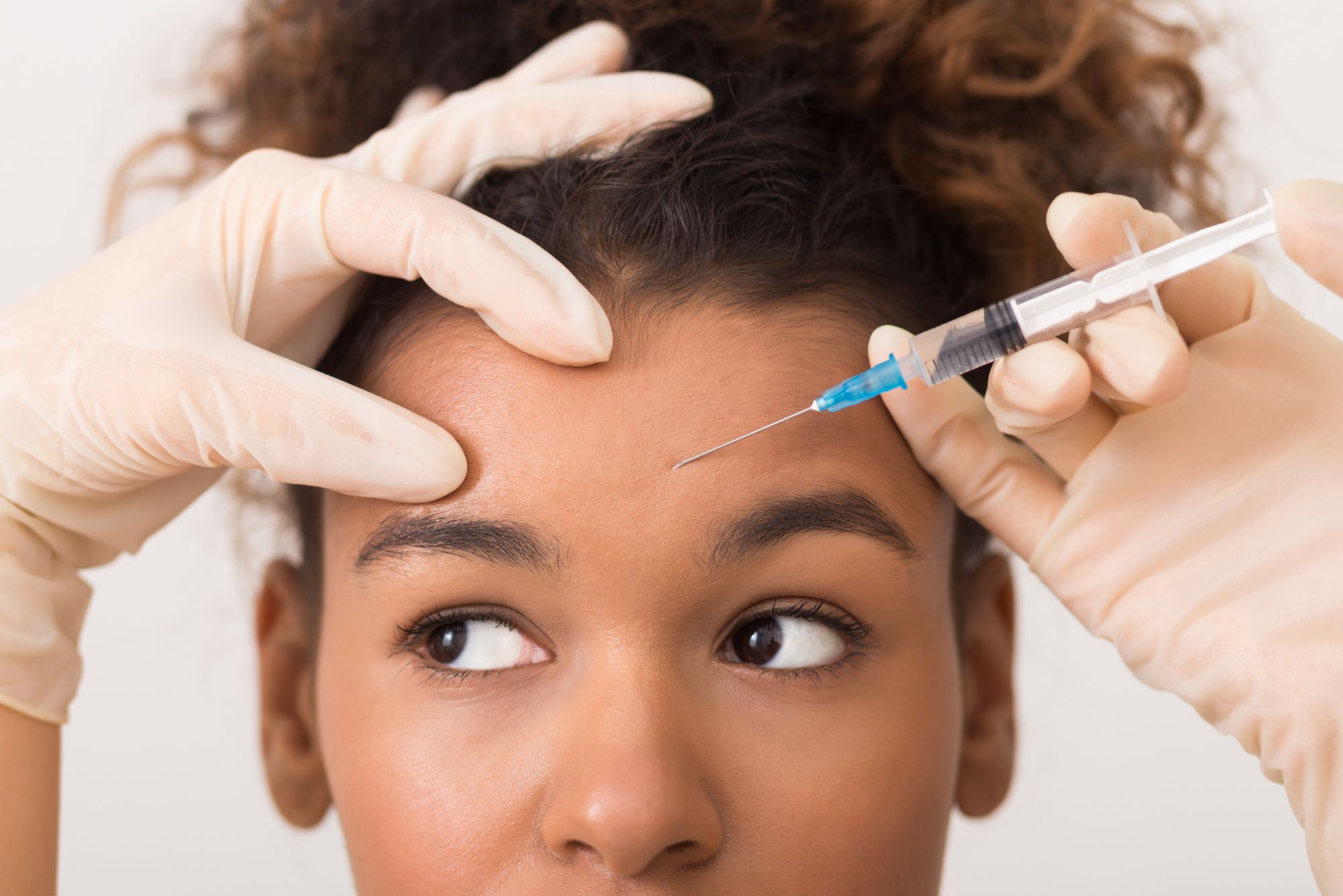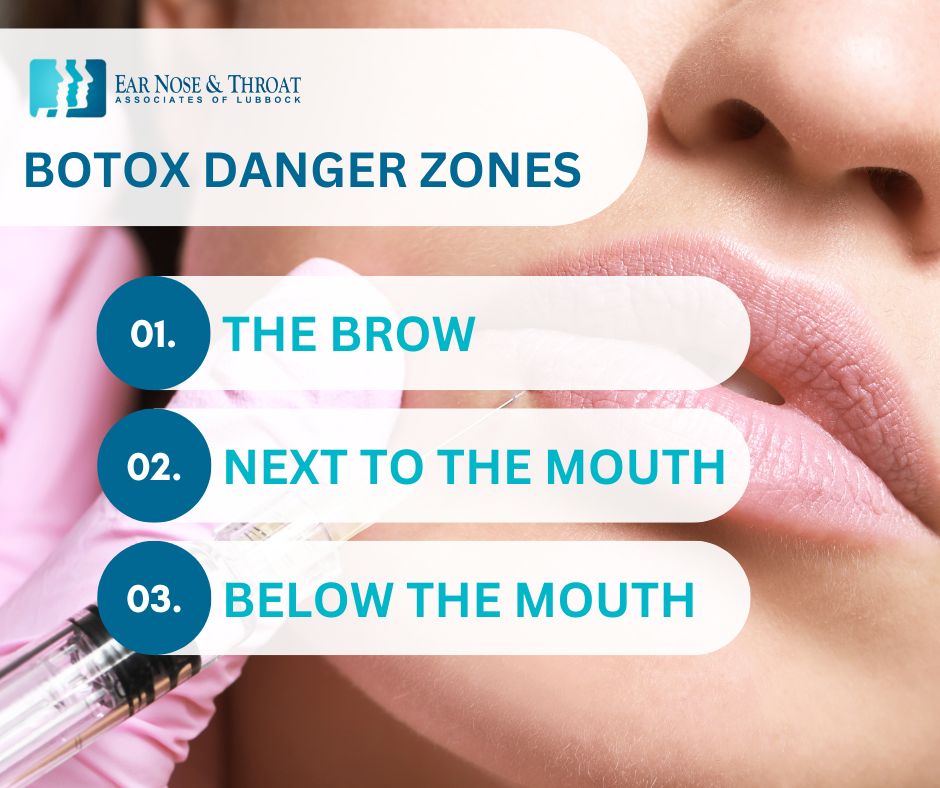3 Botox “Danger Zones” to Watch Out For

When it comes to Botox “danger zones,” it’s not so much that you shouldn’t inject particular regions of your face — it’s that you really need to know what you’re doing.
Every region has subtleties that require a thorough understanding of the facial muscles, their functions, interactions, and more. If someone isn’t intimately familiar with the details, they could end up injecting the wrong amount, the wrong muscle, or no muscle at all.
Why Botox “Danger Zones” Can Cause Problems
In order to avoid Botox danger zones, it’s important for Botox providers to really know facial musculature and how different muscle groups interact. Otherwise, they won’t have an adequate picture of where to inject — and where NOT to inject — the medication.
For example, the frontalis muscle of the forehead has two lobes that come together in the center, but with a gap in one area. It’s possible to miss the muscle entirely if someone injects the center of the forehead without understanding where that gap is. The drug then can’t do its job because it’s not in the muscle.
Besides not producing the desired results, that’s just a waste of money.
There’s more nuance to Botox than first meets the eye if a provider wants to get the exact result a patient is after. Some other problems with Botox danger zones include injecting too many units into a muscle, injecting the wrong spot in a muscle, or accidentally injecting a nearby muscle. It’s even important to understand where not to inject Botox to achieve a certain effect.

3 Botox Danger Zones
Three particular facial areas qualify as “Botox danger zones” because they require caution and expertise to achieve effective, natural-looking results and avoid mishaps. Again, knowing where to inject and where not to inject is crucial to achieving great results.
Botox Danger Zone #1: The Brow
Many of us have seen perpetually surprised-looking Botox patients on TV shows and recognize that something went wrong there. That look, among other things, is a reason the brow/forehead is a Botox danger zone.
That frontalis muscle we mentioned above is responsible for forehead wrinkles, but it’s also in charge of raising the eyebrows. It works in tandem with another muscle around the eyes — the orbicularis oculi — which pulls your eyebrows in the opposite direction. Together, these muscles give your face great flexibility of expression.
Brow Droop
If a Botox provider injects too much above the brow, they can paralyze the frontalis muscle. The wrinkles are taken care of, but the patient won’t be able to raise their eyebrows. Their forehead will be frozen, and the muscles around the eyes won’t encounter any resistance when they pull downward, resulting in a drooping brow.
Eyelid Droop
Another danger-zone problem gained attention in 2021 when a lifestyle blogger and influencer from Chicago shared her story of Botox gone wrong. Botox eyelid droop can happen when a provider injects between the eyebrows improperly. The Botox can migrate and infiltrate a nerve that controls eyelid muscle movement, producing sometimes shocking results.
Raised Brow
Drooping issues aren’t the only problems in Botox danger zones. A raised brow can be just as unpleasant.
If a Botox provider only injects the muscle around the eyes, then a patient can end up with the perpetually surprised look we mentioned earlier. When only the downward-pulling muscle weakens, the upward-pulling muscle (the frontalis) is free to keep those eyebrows hiked up high all the time.
Or, if an inexperienced provider injects too much Botox above the middle of an eyebrow, and not enough above the outside edge, the patient can end up with an unfortunate Spock-like tilt to their eyebrows.
Botox Danger Zone #2: Next to the Mouth
Another Botox danger zone is the area next to your mouth, which contains a number of muscles that help with facial expression and mouth movement. These muscles can vary in size and even location among different people, so experience and expertise are crucial.
The primary problem in this danger zone is a flat or otherwise altered smile from Botox injections for jaw thinning or to treat TMJ disorder.
TMJ (temporomandibular joint) disorder affects an estimated 5–12% of people, and women at least twice as often as men. It can cause intense pain and interfere significantly with daily life. Physicians discovered that using Botox to weaken the masseter, the large chewing muscle that runs from the cheek to the lower jaw, can help relieve TMJ symptoms.
This same treatment can also serve cosmetic purposes, giving the jaw a slimmer appearance by relaxing the masseter.
In both cases, the trouble comes when a provider injects too far forward into the masseter, affecting an adjacent muscle called the risorius. The risorius stretches from the corner of your mouth back toward the masseter and pulls your mouth out and up for a smile — unless it’s inadvertently paralyzed by a misplaced Botox injection.
Botox Danger Zone #3: Below the Mouth
Some people would like a lift to the corners of their mouth, especially if they feel they appear to be constantly frowning. This is where we encounter the final Botox danger zone.
Small doses of Botox, carefully administered, can weaken a muscle called the depressor anguli oris and reduce its downward pull. Precision and experience are the keys here. Mistakes in this area can not only affect the appearance of a patient’s smile but also their ability to eat and drink properly.
How to Reduce Risk in Botox Danger Zones
Many people aren’t familiar with all the potential side effects of Botox and may not realize the complex knowledge necessary to properly administer injections. It seems simple enough, but without the right knowledge and experience, it’s easy to make a mistake that will affect someone’s life for months.
This is why we recommend getting your Botox injections from an experienced, trained physician with an intimate understanding of facial anatomy. They know where to inject and where not to inject to achieve the best results, especially in Botox danger zones. Their expertise even allows them to customize treatments to each patient while significantly reducing your chance of a mishap.
Dr. Cuthbertson is a physician at Ear Nose & Throat Associates of Lubbock. He joined the team at ENT Lubbock from Houston, where he was chief resident of the prestigious Bobby R. Alford Department of Otolaryngology at Baylor College of Medicine. He is board certified in Otolaryngology and Head & Neck Surgery and has quickly built a reputation, not only as an extremely skilled surgeon, but as an approachable and compassionate clinician adept in the newest standards and technologies. Learn more about Dr. Cuthbertson.
Categories:








